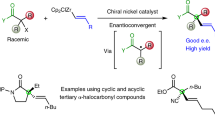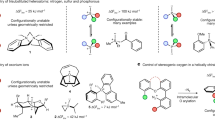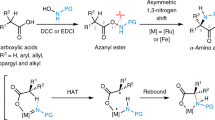Abstract
Control of molecular chirality is a fundamental challenge in organic synthesis. Whereas methods to construct carbon stereocentres enantioselectively are well established, routes to synthesize enriched heteroatomic stereocentres have garnered less attention1,2,3,4,5. Of those atoms commonly present in organic molecules, nitrogen is the most difficult to control stereochemically. Although a limited number of resolution processes have been demonstrated6,7,8, no general methodology exists to enantioselectively prepare a nitrogen stereocentre. Here we show that control of the chirality of ammonium cations is easily achieved through a supramolecular recognition process. By combining enantioselective ammonium recognition mediated by 1,1′-bi-2-naphthol scaffolds with conditions that allow the nitrogen stereocentre to racemize, chiral ammonium cations can be produced in excellent yields and selectivities. Mechanistic investigations demonstrate that, through a combination of solution and solid-phase recognition, a thermodynamically driven adductive crystallization process is responsible for the observed selectivity. Distinct from processes based on dynamic and kinetic resolution, which are under kinetic control, this allows for increased selectivity over time by a self-corrective process. The importance of nitrogen stereocentres can be revealed through a stereoselective supramolecular recognition, which is not possible with naturally occurring pseudoenantiomeric Cinchona alkaloids. With practical access to the enantiomeric forms of ammonium cations, this previously ignored stereocentre is now available to be explored.
This is a preview of subscription content, access via your institution
Access options
Access Nature and 54 other Nature Portfolio journals
Get Nature+, our best-value online-access subscription
$29.99 / 30 days
cancel any time
Subscribe to this journal
Receive 51 print issues and online access
$199.00 per year
only $3.90 per issue
Buy this article
- Purchase on Springer Link
- Instant access to full article PDF
Prices may be subject to local taxes which are calculated during checkout




Similar content being viewed by others
Data Availability
Full crystallographic details in CIF format have been deposited in the Cambridge Crystallographic Data Centre database (deposition numbers: CCDC-1987042–1987058; 1987061–1987068; 1987165–1987180; 2047299–2047303). All other data are available from the corresponding author upon request.
References
Knouse, K. W. et al. Unlocking P(V): reagents for chiral phosphorothioate synthesis. Science 361, 1234–1238 (2018).
Hayakawa, Y., Hyodo, M., Kimura, K. & Kataoka, M. The first asymmetric synthesis of trialkyl phosphates on the basis of dynamic kinetic resolution in the phosphite method using a chiral source in a catalytic manner. Chem. Commun. 1704–1705 (2003).
Bergin, E. et al. Synthesis of P-stereogenic phosphorus compounds. Asymmetric oxidation of phosphines under Appel conditions. J. Am. Chem. Soc. 129, 9566–9567 (2007).
Pitchen, P., Duñach, E., Deshmukh, M. N. & Kagan, H. B. An efficient asymmetric oxidation of sulfides to sulfoxides. J. Am. Chem. Soc. 106, 8188–8193 (1984).
Liu, G., Cogan, D. A. & Ellman, J. A. Catalytic asymmetric synthesis of tert-butanesulfinamide. Application to the asymmetric synthesis of amines. J. Am. Chem. Soc. 119, 9913–9914 (1997).
Wedekind, E. Zur charaktersitik stereoisomerer Ammoniumsaize. J. Chem. Soc. 32, 3561–3569 (1899).
Wedekind, E. & Wedekind, O. Über die Aktivierung einer cyclischen asymmetrischen Ammoniumbase. Chem. Ber. 40, 4450–4456 (1907).
Fröhlich, E. & Wedekind, E. Über asymmetrische ammoniumsaize des p-anisidins. Chem. Ber. 40, 1009–1013 (1907).
Lehn, J.-M. Nitrogen inversion. Fortschr. Chem. Forsch. 15, 311–377 (1970).
Dolling, U.-H., Davis, P. & Grabowski, E. J. J. Efficient catalytic asymmetric alkylations. 1. Enantioselective synthesis of (+)-indacrinone via chiral phase-transfer catalysis. J. Am. Chem. Soc. 106, 446–447 (1984).
Brown, D. R., Lygo, R., McKenna, J., McKenna, J. M. & Hutley, B. G. The preferred steric course of quaternisation of 1-alkylpiperidines. J. Chem. Soc.1967 1184–1194 (1967).
Brois, S. J. Aziridines. XI. Nitrogen inversion in N-haloaziridines. J. Am. Chem. Soc. 90, 506–508 (1968).
Montanari, F., Moretti, I. & Torre, G. Asymmetric introduction at trivalent nitrogen. Optically active 2-methyl-3,3-diphenyloxaziridine, a compound with molecular asymmetry due solely to the nitrogen atom. Chem. Commun. 1968, 1694–1695 (1968).
Mannschreck, A. & Seitz, W. Separation of invertomers (diastereoisomers) of diaziridines. Slow inversion at tervalent nitrogen atoms. Angew. Chem. Int. Edn Engl. 8, 212–213 (1969).
Prelog, V. & Wieland, P. Über die Spaltung der Tröger’schen Base in optische Antipoden, ein Beitrag zur Stereochemie des dreiwertigen Stickstoffs. Helv. Chim. Acta 27, 1127–1134 (1944).
Wilen, S. H., Qi, J. Z. & Williard, P. G. Resolution, asymmetric transformation, and configuration of Troeger’s base. Application of Troeger’s base as a chiral solvating agent. J. Org. Chem. 56, 485–487 (1991).
Pope, W. J. & Peachey, S. J. Asymmetric optically active nitrogen compounds. Dextro- and laevo-benzylphenylallylmethylammonium iodides and bromides. J. Chem. Soc. 75, 1127–1131 (1899).
Havinga, E. Spontaneous formation of optically active substances. Biochim. Biophys. Acta 13, 171–174 (1954).
Kostyanovsky, R. G., Lyssenko, K. A., Krutiusa, O. N. & Kostyanovsky, V. R. Isomorphism of chiral ammonium salts Ph(All)N+Et(Me)X–·CHCl3. Mendeleev Commun. 19, 19–20 (2009).
Torbeev, V. Y., Lyssenko, K. A., Kharybin, O. N., Antipin, M. Y. & Kostyanovsky, R. G. Lamellar racemic twinning as an obstacle for the resolution of enantiomers by crystallization: the case of Me(All)N+(CH2Ph)Ph X- (X = Br, I) salts. J. Phys. Chem. B 107, 13523–13531 (2003).
Tanaka, K., Okada, T. & Toda, F. Separation of enantiomers of 2,2′-dihydroxy-1, 1′-binaphthyl and 10,10′-dihydroxy-9,9′-biphenanthryl by complexation with n-alkylcinchonidinium halides. Angew. Chem. Int. Edn Engl. 32, 1147–1148 (1993).
Toda, F., Tanaka, K., Stein, Z. & Goldberg, I. Optical resolution of binaphthyl and biphenanthryl diols by inclusion crystallization with N-alkylcinchonidium halides. Structural characterization of the resolved materials. J. Org. Chem. 59, 5748–5751 (1994).
Du, H. et al. A new method for optical resolution of BINOL by molecular complexation with (S)-5-oxopyrrolidine-2-carboxanilide. Tetrahedr. Lett. 43, 5273–5276 (2002).
Deng, J. et al. Resolution of omeprazole by inclusion complexation with a chiral host BINOL. Tetrahedron Asymmetry 11, 1729–1732 (2000).
Schanz, H. J., Linseis, M. A. & Gilheany, D. G. Improved resolution methods for (R,R)- and (S,S)-cyclohexane-1,2-diamine and (R)- and (S)-BINOL. Tetrahedron Asymmetry 14, 2763–2769 (2003).
Roy, B. N. et al. A novel method for large-scale synthesis of lamivudine through cocrystal formation of racemic lamivudine with (S)-(−)-1,1′-Bi(2-naphthol) [(S)-(BINOL)]. Org. Process Res. Dev. 13, 450–455 (2009).
Ratajczak-Sitarz, M., Katrusiak, A., Gawrońska, K. & Gawroński, J. Racemate resolution via diastereomeric helicates in hydrogen-bonded co-crystals: the case of BINOL-diamine complexes. Tetrahedron Asymmetry 18, 765–773 (2007).
Jin, S., Dong, Q., Wang, D. & Zhou, W. Six hydrogen bond directed supramolecular adducts formed between racemic-bis-β-naphthol and N-containing aromatic bases. J. Mol. Struct. 1013, 143–155 (2012).
Tayama, E. & Tanaka, H. An efficient optical resolution of nitrogen-centered chiral beta-hydroxy-tetraalkylammonium salts via complexation with (R)-BINOL. Tetrahedr. Lett. 48, 4183–4185 (2007).
Tayama, E., Otoyama, S. & Tanaka, H. Resolution of nitrogen-centered chiral tetraalkylammonium salts: application to [1,2] Stevens rearrangements with N-to-C chirality transmission. Tetrahedron Asymmetry 20, 2600–2608 (2009).
Shirakawa, S. et al. Tetraalkylammonium salts as hydrogen-bonding catalysts. Angew. Chem. Int. Ed. 54, 15767–15770 (2015).
Pike, S. J., Lavagnini, E., Varley, L. M., Cook, J. L. & Hunter, C. A. H-bond donor parameters for cations. Chem. Sci. 10, 5943–5951 (2019).
Hunter, C. A. Quantifying intermolecular interactions: guidelines for the molecular recognition toolbox. Angew. Chem. Int. Ed. 43, 5310–5324 (2004).
Taylor, R. & Kennard, O. Crystallographic evidence for the existence of C—H···O, C—H···N, and C—H···Cl hydrogen bonds. J. Am. Chem. Soc. 104, 5063–5070 (1982).
Lacour, J., Vial, L. & Herse, C. Efficient NMR enantiodifferentiation of chiral quats with BINPHAT anion. Org. Lett. 4, 1351–1354 (2002).
Lacour, J., Londez, A., Goujon-Ginglinger, C., Buss, V. & Bernardinelli, G. Configurational ordering of cationic chiral dyes using a novel C(2)-symmetric hexacoordinated phosphate anion. Org. Lett. 2, 4185–4188 (2000).
Michon, C., Gonçalves-Farbos, M.-H. & Lacour, J. NMR enantiodifferentiation of quaternary ammonium salts of Tröger base. Chirality 21, 809–817 (2009).
Steed, K. M. & Steed, J. W. Packing problems: high Z′ crystal structures and their relationship to cocrystals, inclusion compounds, and polymorphism. Chem. Rev. 115, 2895–2933 (2015).
Spackman, M. A. & Jayatilaka, D. Hirshfield surface analysis. CrystEngComm 11, 19–32 (2009).
Gavezzotti, A. Are crystal structures predictable? Acc. Chem. Res. 27, 309–314 (1994).
Gavezzotti, A. & Fillipini, G. Geometry of the intermolecular X–H···Y (X, Y = N, O) hydrogen bond and the calibration of empirical hydrogen-bond potentials. J. Phys. Chem. 98, 4831–4837 (1994).
Mullin, J. W. in Ullman’s Encylopedia of Industrial Chemistry Vol. 10 (ed. Elvers, B.) 582–630 (Wiley-VCH, 2012).
Kulchat, S. & Lehn, J.-M. Dynamic covalent chemistry of nucleophilic substitution component exchange of quaternary ammonium salts. Chem. Asian J. 10, 2484–2496 (2015).
Lee, I., Park, Y. K., Huh, C. & Lee, H. W. Nucleophilic substitution reaction of benzyl bromide with N,N‐dimethylaniline: significance of equilibrium cross‐interaction constant. J. Phys. Org. Chem. 7, 555–560 (1994).
Bordwell, F. G. & Hughes, D. L. Rate-equilibrium relationships for reactions of families of carbanion nucleophiles with N-benzyl-N,N-dimethylanilinium cations and with alkyl chlorides, bromides, and iodides. J. Am. Chem. Soc. 108, 7300–7309 (1986).
Abboud, J.-L. M., Notario, R., Bertran, J. & Sold, M. in Progress in Physical Organic Chemistry (ed. Taft, R. W.) (Wiley, 1993).
Keith, J. M., Larrow, J. F. & Jacobsen, E. N. Practical considerations in kinetic resolution reactions. Adv. Synth. Catal. 343, 5–26 (2001).
Brands, K. M. J. & Davies, A. J. Crystallization-induced diastereomer transformations. Chem. Rev. 106, 2711–2733 (2006).
Flack, H. D. On enantiomorph-polarity estimation. Acta Crystallogr. A 39, 876–881 (1983).
Genov, G. R., Douthwaite, J. L., Lahdenperä, A. S. K., Gibson, D. C. & Phipps, R. J. Enantioselective remote C–H activation directed by a chiral cation. Science 367, 1246–1251 (2020).
Wang, Y., Sun, J. & Ding, K. Practical method and novel mechanism for optical resolution of BINOL by molecular complexation with N-benzylcinchoninium chloride. Tetrahedron 56, 4447–4451 (2000).
Acknowledgements
We acknowledge funding from The Royal Society to M.O.K in the form of a University Research Fellowship (UF150536) and equipment grant (RGS\R2\180467) award. Durham University is acknowledged for providing a doctoral studentship (M.P.W.). J.M.P acknowledges support from the Laidlaw Undergraduate Research and Leadership programme in the form of a scholarship. The Royal Society is also acknowledged for providing M.E.L. with funding for a summer studentship. We thank our colleagues at Durham University and beyond, as well as members of the Kitching group, for input and advice during the preparation of this manuscript.
Author information
Authors and Affiliations
Contributions
The project was conceived by M.O.K. and M.P.W. Experiments were devised by M.O.K. and M.P.W. M.P.W., J.M.P. and M.E.L. carried out starting material synthesis for the project. M.P.W. carried out experimental work to develop the enantioselective recognition, dynamic studies and enantioselective syntheses. X-ray crystallography was conducted by M.P.W. and D.S.Y. The manuscript was prepared by M.O.K. and M.P.W. with input from all authors.
Corresponding author
Ethics declarations
Competing interests
The authors have filed a patent on this work (GB2017799.4).
Additional information
Peer review information Nature thanks the anonymous reviewer(s) for their contribution to the peer review of this work.
Publisher’s note Springer Nature remains neutral with regard to jurisdictional claims in published maps and institutional affiliations.
Extended data figures and tables
Extended Data Fig. 1 Recognition screening.
Addition of recognition species (0.5 equiv) to 60 mM solution (CDCl3) of (rac)-1b. Recognition was monitored by observing changes in chemical shift and increased multiplicities of 1H resonances of salt (rac)-1b.
Extended Data Fig. 2 Crystal structure of ternary complex 2b.
a, The asymmetric unit (P43). b, Viewed along the b axis. c, Viewed along the c axis.
Extended Data Fig. 3 BINOL–halide network.
The (R)-BINOL and bromide counterions of complex 2d are shown as a van der Waals surface (teal), displaying the chiral hydrogen-bond network that encapsulates the ammonium cation (S)-1d.
Extended Data Fig. 4 Control reactions.
a, Table of control reactions, demonstrating the requirement for correct balance of temperature, alkylating agent and concentration for optimal results. b, Analysis of both the solid and solution phases of the reaction mixture. Both phases show bias towards the (S) enantiomer of the quaternary ammonium cation.
Extended Data Fig. 5 Ammonium hexafluorophosphate salts.
a, X-ray crystal structures of enantioenriched hexafluorophosphate salts (S)-1t and (R)-1t. b, Evaluation of the stereochemical stability of (S)-1t and (R)-1t by exposing both enantiomers to conditions previously used to racemize ammonium halide salts, while also observing minimal changes to their optical activity after 24 h.
Supplementary information
Rights and permissions
About this article
Cite this article
Walsh, M.P., Phelps, J.M., Lennon, M.E. et al. Enantioselective synthesis of ammonium cations. Nature 597, 70–76 (2021). https://doi.org/10.1038/s41586-021-03735-5
Received:
Accepted:
Published:
Issue Date:
DOI: https://doi.org/10.1038/s41586-021-03735-5
This article is cited by
Comments
By submitting a comment you agree to abide by our Terms and Community Guidelines. If you find something abusive or that does not comply with our terms or guidelines please flag it as inappropriate.



